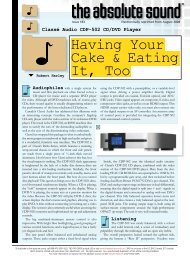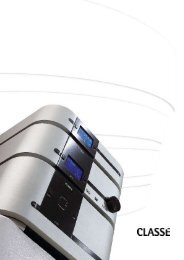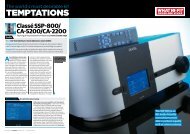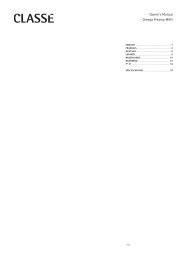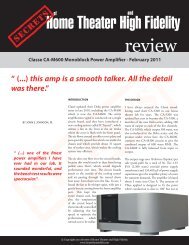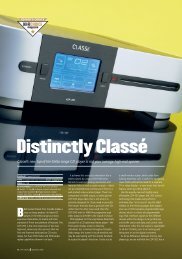You also want an ePaper? Increase the reach of your titles
YUMPU automatically turns print PDFs into web optimized ePapers that Google loves.
Classé<br />
<strong>Delta</strong> <strong>Series</strong><br />
SSP-800 Surround Sound<br />
Preamp/Processor And<br />
CA-M400 And CA-3200<br />
Power Amplifiers<br />
Gary Reber<br />
Introduction<br />
The Classé <strong>Delta</strong> <strong>Series</strong> products are stunning performers,<br />
with especially attractive physical designs featuring thick,<br />
machine-curved aluminum fascias and contrasting matte satin<br />
silver and black panels. The build quality is exceptional as well,<br />
which is what enthusiasts should appreciate because build<br />
quality is the foundation of high performance. And the new<br />
Classé <strong>Delta</strong> <strong>Series</strong> range of products are expertly engineered,<br />
resulting in a significant improvement over past Classé designs,<br />
which will delight Classé’s audiophile customers and those new<br />
to the brand as well.<br />
The subject of this review is Classé’s SSP-800 Surround<br />
Sound Preamp/Processor and CA-M400 and CA-3200<br />
Power Amplifiers. These particular units<br />
have been essential components of<br />
the Widescreen Review principal<br />
reference system for more than 18<br />
months now. The SSP-800 was<br />
recently upgraded to fully process<br />
both 7.1-channel lossless Dolby ®<br />
TrueHD and DTS-HD Master<br />
<strong>Audio</strong> codecs. (A free upgrade is<br />
available to SSP-800 owners who<br />
purchased prior to the on-board<br />
inclusion on SSP-800 built after<br />
June 2009.) The result has been<br />
flawless performance with no sonic<br />
problems encountered during<br />
HDMI switching and processing,<br />
which has been problematic for<br />
other manufacturers’ preamp/processors<br />
we have used and<br />
reviewed. The Classé components<br />
are used day-in and day-out in our<br />
principal reference system, to<br />
review Blu-ray Discs and to<br />
access Blu-ray Disc players.<br />
The <strong>Delta</strong> <strong>Series</strong> has had a<br />
long development period, with the<br />
primary focus on sound quality. I<br />
applaud such attention as I have<br />
stated numerous times in WSR that<br />
the perceived performance in<br />
experiencing a motion picture is 80<br />
percent attributable to the quality of the soundtrack. While a picture<br />
may be worth a thousand words, the sound is what really cements<br />
the experience, and the better the quality the better the motion picture<br />
experience, no matter how exquisite the picture quality is. Sound<br />
quality is an even more important attribute to elicit emotional<br />
responses.<br />
SSP-800 Description<br />
Starting over two years ago, the Classé Design Team began an<br />
extensive evaluation of the new breed of high-definition audio and<br />
video technologies, with the aim of creating the definitive SSP––a surround<br />
sound processor that would become the Classé statement preamp/processor.<br />
I have found that the SSP-800 is fully capable of the<br />
faithful reproduction of the audio and video, as delivered in the form<br />
of an original master, reproducing music and motion pictures exactly<br />
as their creators intended.<br />
When the SSP-800 was first introduced, it lacked decoding for the<br />
Dolby and DTS ® lossless HD audio formats, relying on the source<br />
Blu-ray Disc player to decode the bitstreams to linear PCM. While it<br />
still does not provide automated room-EQ or self-set-up and video<br />
upscaling, these are features that are not a requirement of an SSP. I<br />
have always preferred manual room-EQ and setup, and video<br />
upscaling is regularly a feature in DVD and Blu-ray Disc players. The<br />
Classé SSP-800 is a high-end component that is expensive (MSRP<br />
$8,000) and intended for all-out performance systems equipped with<br />
equally high-end quality source and reproduction components, both<br />
audio and video, and loudspeakers.<br />
The Classé SSP-800 is an audio processor only. There are no<br />
video facilities onboard, except for a functional complement of video<br />
inputs and outputs, which serve as simple pass-throughs, with no<br />
conversion or other processing.<br />
1 Widescreen Review • Issue 147 • March/April 2010<br />
1/6
Classé <strong>Delta</strong> <strong>Series</strong> SSP-800, CA-3200, And CA-M400<br />
CA-3200 Three-Channel Power Amplifier<br />
The Classé power amplifiers in the CA <strong>Series</strong> match the appearance<br />
of the SSP-800, with a physical design featuring thick, machinecurved<br />
aluminum fascias and contrasting matte satin silver and black<br />
panels. The build quality is exceptional as well, as is to be expected<br />
of a Classé component.<br />
Two 200-watt-per-channel CA-3200 three-channel power amplifiers<br />
(MSRP $6,000 each) are used, along with one 400-watt CA-<br />
M400 monobloc power amplifier (MSRP $5,000) in the principal<br />
Widescreen Review reference system.<br />
The CA-3200 power amplifiers drive six Dunlavy Signature <strong>Series</strong><br />
SC-IIIA loudspeakers. The CA-M400 drives a Dunlavy Signature<br />
<strong>Series</strong> SC-I center channel loudspeaker. These are scrupulously<br />
articulate and revealing time-correct loudspeakers, and the Classés<br />
deliver the full measure of the source signals.<br />
Design features of the CA-3200 include balanced circuitry, overbuilt<br />
power supplies, and oversized output stages to ensure demanding<br />
performance at reference motion picture output level. The CA-<br />
M400 uses two 200-watt power modules, one to amplify an inverted<br />
signal, while the other handles a non-inverted signal. Classé’s balanced<br />
output stage cancels noise and distortion and yields higher<br />
power without reducing low-impedance drive capability. High-current<br />
bipolars are used as output devices for amplifier output stages.<br />
Both designs result in largely Class A operation, eliminating the<br />
switching distortion normally associated with a Class A/B design.<br />
The rear panel of the CA-3200 is organized into three outlined<br />
areas, one for each channel. Each area contains the requisite RCA<br />
jack, XLR receptacle, and a pair of multi-way binding posts. Across<br />
the bottom are, from left to right, CANBus, IR, and DC control ports,<br />
an RS-232 connector, a central EIA AC power receptacle, and an AC<br />
mains fuse post. Extensive custom heatsink fins cover each side of<br />
the solid steel chassis substantially.<br />
As with other Classé power amplifiers, both single-ended RCA<br />
and balanced XLR connections can be made simultaneously. For<br />
example, the output of a high-end preamp could be connected to the<br />
balanced inputs for stereo listening, while the RCA single-ended connection<br />
inputs of the amplifier are connected to a surround preamp/processor.<br />
The different inputs can then be selected from the<br />
front panel, or by RS-232, or an external control system.<br />
To set up the inputs, put the amplifier in Standby mode, and using<br />
the Select button, select the channel and choose RCA or XLR input<br />
with the Mode button. That’s it.<br />
Blue LEDs on the front panel indicate the input mode of each<br />
channel and power on. When power is in standby, a single Blue LED<br />
is lit on the power-on button. Should any channel appear with a blinking<br />
Red light, this is an indication that a fault is related to that channel;<br />
three blinking Red lights indicate a systematic problem. I have<br />
had only one instance of a single channel blinking Red during a particularly<br />
energized SPL sequence in a movie soundtrack. To recover,<br />
I unconnected the power cord, waited a couple of seconds, reinserted<br />
the cord, and powered up. Problem fixed.<br />
When you press the Standby button to on, the three channels turn<br />
on sequentially one by one. When pressing the Standby button at the<br />
conclusion of a listening session, the three blue LEDs go dark.<br />
The sound is magnificent, if not better characterized as stunning.<br />
The frequency response is perfectly balanced, and depending on the<br />
recording, bass extension is deep and powerful, extending to below<br />
25 Hz on certain motion picture soundtracks. Thus, powerfully potent<br />
SPL sound effects, such as thunder and synthesized low-frequency<br />
generated bass, are authoritative and startlingly impactful.<br />
Individual instrument timbre is perfectly reproduced, which<br />
enhances the dimensional realism of orchestral recordings and<br />
expansive music scores. Voices sound natural when recorded as<br />
such and imperfections in spatial integration are readily discernable.<br />
Well-recorded vocal recordings exhibit perfect harmonic structure<br />
and dimensionality, with impressive image depth.<br />
High frequencies never sound edgy or stridently bright but<br />
smooth and warm––reminiscent of the best-sounding tube amplifiers.<br />
Strings and symbols sound natural and distinctively dimensional,<br />
while reproducing impressive detail.<br />
As with other highly regarded power amplifiers, the Classé CA-<br />
3200 exemplifies such qualities as dynamic range impact, openness,<br />
transparent and fast transient response, dimensional spatial reproduction,<br />
detail, harmonic richness, high-frequency smoothness and<br />
extension, solid bass extension, low-level and high-level dynamic<br />
resolution, and spatial separation of sounds in complex mixes.<br />
The Classé CA-M400 monobloc power amplifier is a powerhouse,<br />
at twice the rated power of a single CA-3200 channel. It is delegated<br />
to reproducing the center channel signal in multichannel music<br />
recordings and movie soundtracks. The sound is absolutely clean,<br />
open and balanced, perfectly reproducing what the source delivers.<br />
It shares the same wonderful attributes as the CA-3200, but with further<br />
refinement. As a center channel power source, it is perfect at<br />
reproducing complex midrange signals and resolving detail nuances<br />
in dialogue reproduction.<br />
In conclusion, both the Classé CA-3200 power amplifiers and the<br />
CA-M400 power amplifier are impressive performers in their complementary<br />
support of the preamplification provided by the SSP-800. I<br />
cannot fault these amplifiers. As a system providing seven channels<br />
of high-end amplification, they provide stunning transparency, balance,<br />
smoothness, spatial imaging, and dynamics. There is no coloration to<br />
the sound beyond that inherent in the content of the recording. The<br />
build quality is impressive as well, which is an indicator of performance<br />
expectations. The CA <strong>Series</strong> is also available in two- and fivechannel<br />
versions, which should provide an equally impressive listening<br />
experience when mated with accurate loudspeakers.<br />
As such, audio sound quality is paramount. The SSP-800 combines<br />
powerful 64-bit, floating-point, double-precision Texas Instrumentsbased<br />
DSP with balanced topologies, precision component parts, and<br />
meticulous circuit layout. Floating point arithmetic calculations ensure the<br />
most accurate performance. All bass management filters, level adjustments,<br />
and parametric EQ filters benefit from this added precision. The<br />
analog audio circuits are powered by a low-noise toroidal transformer,<br />
while digital and control circuits are powered by their own dual-output,<br />
high-current switching supply. Exceptional dynamic range and resolution<br />
is achieved using high-quality digital-to-analog converters and output<br />
stage components in a fully balanced differential mode. Optocouplers<br />
and low-voltage differential signal (LVDS) pathways isolate audio circuits<br />
from video and control circuits, and digital and analog circuits and grounds<br />
are further isolated from each other throughout the circuit board layout.<br />
Inputs And Outputs<br />
There are four HDMI v.1.3b inputs labeled 1 to 4. These support<br />
1080p @ 24/50/60 frames per second (fps) video, x.v.Color(xvYCC),<br />
and 36-bit Deep Color. HDMI (High-Definition Multimedia Interface) is<br />
the industry standard single-cable digital pathway for both video and<br />
audio signals, and is backwards compatible with the earlier videoonly<br />
DVI (Digital Video Interface) standard. The HDMI standard incorporates<br />
HDCP (High-Definition Content Protection), a separate content-protection<br />
technology, to prevent unauthorized distribution or<br />
duplication of copyrighted material. There are two HDMI v.1.3b outputs,<br />
labeled 1 and 2. Thus, two display systems can be supported.<br />
These outputs additionally provide a two-channel SPDIF downmix of<br />
the source material. Non-HDMI source material is encoded for an<br />
HDMI display at the source’s native video rate (or transcoded to<br />
2/6 www.WidescreenReview.com • Issue 147 • March/April 2010 2
Classé <strong>Delta</strong> <strong>Series</strong> SSP-800, CA-3200, And CA-M400<br />
Specifications – SSP-800 Surround Sound Preamp/Processor<br />
Dimensions: 17.5” W x 6.75” H x 16.5” D<br />
Weight: 29 pounds<br />
Power requirement: 120/220 VAC, 50 or 60 Hz<br />
Power consumption: 75 watts maximum<br />
Channel separation: >100 dB<br />
Gain range: -100 dB to +14 dB<br />
Signal-to-Noise Ratio (reference 10Vrms input): 102 dB bypassed<br />
analog source, 100 dB processed analog source, 105 dB<br />
digital source<br />
THD: .001% digital source/bypassed analog source, .002%<br />
processed analog source<br />
Frequency response: 20Hz-200kHz < 0.1 dB stereo analog bypass,<br />
20Hz-20kHz < 0.2 dB all other sources<br />
Channel separation: better than 100 dB<br />
Crosstalk (any input to any output): better than -120 dB @ 1 kHZ<br />
HDMI: v1.3b supporting Deep Color, 1080p @ 24/50/60 fps, and<br />
x.v.Color(xvYCC)<br />
Manufactured in Canada<br />
5-year warranty, parts and labor<br />
MSRP $8,000<br />
Specifications – CA-3200 Three-Channel Power Amplifier<br />
Dimensions: 17.5” W x 8.75” H x 18.5” D<br />
Weight: 90 pounds (net)<br />
Power requirement: 120VAC, 60Hz<br />
Power consumption: Idle 220 w. – Rated power 672 w.<br />
200 w continuous (23dBW) @ 8 ohms 20Hz-20kHz, 390 w (23dBW)<br />
@ 4 ohms 20Hz-20kHz<br />
Frequency response: 10Hz-22kHz + 0 / - 0.1 dB, 10Hz-155kHz<br />
+ 0 / - 3 dB<br />
THD+Noise: less than 0.003% at rated power into 8 ohms, less<br />
than 0.005% at rated power into 4 ohms (unweighted, 1V<br />
RMS/1kHz input, 10Hz-500kHz)<br />
Signal-to-Noise ratio: better than 120 dB reference full output,<br />
10Hz-80kHz<br />
Noise floor FFT: all peaks under -95dB, 10Hz-80kHz<br />
Phase error:
Classé <strong>Delta</strong> <strong>Series</strong> SSP-800, CA-3200, And CA-M400<br />
Issue 142, September 2009 entitled “The Art & Science Of 7.1 Surround<br />
Sound: Time To Get It Right”). Two additional programmable<br />
XLR/RCA outputs are provided for the following assignment purposes:<br />
• Assigned as a two-channel down-mix of the selected multichannel<br />
signal for either an analog recorder or a separate listening area.<br />
• Assigned to follow the main Front L/R loudspeakers for use in a<br />
biamplification arrangement.<br />
• One or both may be assigned as additional subwoofers, with<br />
the ability to select between monaural and stereo modes.<br />
The AC power cord is detachable so that an audiophile may<br />
experiment with other power cords.<br />
The Remote Control<br />
The remote control is a beautiful, full-sized, weighty hand sculpture<br />
hewn from an aluminum ingot. The unit is versatile, with control<br />
functions for both the SSP-800 processor itself and several aspects<br />
of the rest of a Classé-based system.<br />
presents the normal operation options––Source, Mode, Video<br />
Preview, and Controls. The return home works no matter how deep<br />
you have navigated.<br />
• Navigation Arrows are the Up (), Down (), Left (⊳), and Right<br />
() arrow buttons, which allow you to select the different menu options.<br />
• Enter selects the menu option that is highlighted.<br />
• Profile accesses customized versions of the system’s Home<br />
screen that you have pre-programmed to provide direct access to<br />
frequently used controls.<br />
• Trim accesses the System Trim menu screen, which allows you<br />
to make temporary adjustments to loudspeaker levels and the lipsync<br />
feature. These temporary trims do not override the settings you<br />
made through the Setup menu and are discarded when you select a<br />
new source.<br />
At the bottom are four Function buttons (F1 to F4) or FKeys, which<br />
provide additional flexibility to the SSP-800 remote control. Likened to<br />
“favorites,” they provide instant access to a specific system function<br />
The Classé SSP-800 is a purist performance product<br />
with respected audiophile credentials.<br />
Four buttons along the top groups the following basic control<br />
functions:<br />
• Backlighing Light button, which automatically switches off after<br />
a few moments of inactivity.<br />
• Info button opens the Status LCD display on the SSP-800 front<br />
panel touchscreen.<br />
• Display button cycles through the three brightness levels of the<br />
front panel touchscreen display.<br />
• Standby button switches the SSP-800 between the Standby and<br />
Operate stages.<br />
Reading downward, the next three buttons offer the following processing<br />
controls for the audio signal:<br />
• Lipsync button delays the arrival time of the audio portion of the<br />
audio/video source. Video processing often delays video signals relative<br />
to the audio, with the result being that the audio track is played<br />
too early. This is the singular gripe I have with the SSP-800. The<br />
video pass-through always significantly delays the video up to five<br />
seconds. The Lipsync function is not designed to correct this problem.<br />
This problem is there at the start of every movie or supplemental<br />
special feature and following pauses in the program.<br />
• Night button engages or disengages the Night mode for Dolby<br />
Digital soundtracks, but not for Dolby TrueHD soundtracks. This is a<br />
dynamic range compressor circuit that reduces peaks and increases<br />
low-level passages.<br />
• Mode button displays the available surround modes on the front<br />
panel touchscreen. Pressing the navigation arrow keys moves up<br />
and down the list. Pressing Enter activates your selection.<br />
The Input Sel (selection) button steps through the available<br />
inputs. You can selectively activate or deactivate unused inputs to<br />
make the SSP-800 easier to navigate.<br />
The Preset Config (configuration) button steps through the configurations<br />
set to “in use.”<br />
Volume Control and Mute buttons are self-explanatory.<br />
Navigation and Menu buttons are found at the central section of<br />
the remote control. Each of the buttons perform the following navigating<br />
function(s):<br />
• Menu accesses the main screen for the menu system just as on<br />
the front panel.<br />
• Home returns the touchscreen display to the Home page, which<br />
that might be otherwise buried in the menu system, such as a command<br />
not covered by the other buttons. For example, the manual<br />
suggests that if you use the balance control frequently, you may want<br />
to consider programming one of the FKeys to directly access the balance<br />
control. By saving the balance control as an FKey, you do not<br />
need to access the menus to change the parameter.<br />
SSP-800 Setup<br />
Menu settings are straightforward, and the owner’s manual has<br />
useful explanations for each function, should there be any question<br />
about what setting is best. The SSP-800’s LCD touchscreen is useful<br />
for day-to-day operations and provides access to all setup functions,<br />
which are extensive. The Home page, which can also be accessed<br />
from the remote control, displays four options––Source, Video<br />
Preview, Mode, and Controls––on the top of the touchscreen. The<br />
bottom half of the screen displays the active input, surround processing<br />
mode, plus the current volume level (in both a graphical bar<br />
across the bottom of the screen and as a large numeric decibel value).<br />
The Source option provides for a total of 20 selectable inputs,<br />
which are all interchangeable. The Mode button is used to activate<br />
the available inputs with components connected to them. You can<br />
deactivate any unused inputs, and the input button is removed from<br />
the Source selection menu. This reduces the number of input options<br />
that are not used.<br />
You can specify default surround processing modes for each<br />
active input. But you can also modify the default on the fly, for say, a<br />
particular recording. For example, you can choose to listen in monaural,<br />
using only the center-channel loudspeaker. To do this, you<br />
touch the up or down arrows to scroll through the list of modes:<br />
• Mono––outputs sound to the center channel only<br />
• Stereo––outputs sound to the Front Left and Front Right<br />
channels only<br />
• Music Mode Party––produces mono output at the same level<br />
from all available loudspeakers<br />
• Movie Plus––produces stereo output in all available loudspeakers<br />
with a 60 percent center width and a 50/50 front-to-surround distribution<br />
and 15 percent to the rear channels<br />
• Music Plus––produces stereo output in all available loudspeakers<br />
4/6 www.WidescreenReview.com • Issue 147 • March/April 2010 4
Classé <strong>Delta</strong> <strong>Series</strong> SSP-800, CA-3200, And CA-M400<br />
with 25 percent center width, a 70/30 front-to-surround distribution,<br />
and 15 percent to the rear channels<br />
• Dolby ProLogic II––provides audio signals<br />
for a 5-channel surround sound field<br />
from matrix-encoded stereo sources<br />
• Dolby ProLogic IIx Music––Expands<br />
existing stereo or 5.1-channel matrix-encoded<br />
audio signals for 6.1- or 7.1-channel discrete<br />
playback and features three additional<br />
user controls: Center Width (for adjusting<br />
balance to favor the Center or Left and<br />
Right front channels), Panorama (for wrapa-round<br />
surround effects), and Dimension<br />
(to adjust the depth of the surround sound<br />
field)<br />
• Dolby ProLogic IIx Movie––routes the<br />
special effects signals to the surround<br />
channels<br />
• Dolby ProLogic IIx Matrix––provides<br />
soundfield similar to the Music mode, without<br />
the additional adjustment options<br />
• Dolby ProLogic IIx Game––routes the special effects signals to<br />
the surround channels<br />
• DTS Neo6––expands existing stereo or 5.1-channel matrixencoded<br />
audio signals for playback with 6.1- or 7.1-channel systems<br />
• DTS Neo6 Cinema––emphasizes front information and processes<br />
surround effects, to reproduce a very diffuse rear soundfield<br />
• DTS Neo6 Music––expands non-encoded stereo audio tracks<br />
with a Center Width adjustment<br />
• Discrete––provides a “native” pass-through format mode, where no<br />
processing is performed for Dolby Digital, DTS Digital Surround, Dolby<br />
TrueHD, and DTS-HD Master <strong>Audio</strong> signals up to 7.1 discrete channels<br />
• DTS Neo6 Cinema ES––provides the DTS Neo6 mode with the<br />
addition of discrete- or matrix-encoding to the surround back channels<br />
• DTS Neo6 Music ES––provides the DTS Neo6 mode with the<br />
addition of discreet- or matrix-encoding to the surround back channels<br />
• Dolby Surround EX––derives matrix-encoded rear-channel audio<br />
signals from channel audio signal sources<br />
• Dolby Digital EX––derives the seventh channel of discrete information<br />
encoded into the soundtrack used to create a single rear channel,<br />
or two monaural rear centers, depending on the loudspeaker setup<br />
There are no gimmicky jazz club, arena, or other surround modes<br />
of questionable or negative value.<br />
Unfortunately, however, is the lack of Home THX ® processing modes,<br />
in particular Re-EQ. A Re-EQ circuit is still necessary for those occasional<br />
motion picture soundtracks that have not been re-equalized during<br />
mastering, to tame the otherwise excessive brightness of the sound.<br />
Classé could have opted to provide such a circuit without THX licensing<br />
but did not. Recognizing the need, a firmware upgrade is in the works<br />
to add a Re-EQ circuit (see the company’s Web site for updates).<br />
Video Preview allows you to select and view the video source on the<br />
front panel touchscreen. But do not expect the aspect ratio of any given<br />
program to be accurate. Still, this is a nice feature, particularly during setup.<br />
There are Systems Trims, which provide for adjustments for level<br />
trims, audio delay (called Lipsync), and Dolby late night dynamic range.<br />
Touching the Configuration option opens the Configuration Select<br />
menu, which allows you to select the current configuration you want<br />
to activate. There are six different system configurations, which<br />
reflect the loudspeaker setup of our system. You can use different<br />
configurations that you call stereo and movies for configuring your<br />
system for full-range, two-channel versus bass-managed multichannel<br />
with subwoofers. You may also use configurations to optimize levels<br />
and loudspeaker distances for different listening positions.<br />
The Menu System is extensive and provides complete flexibility<br />
and control for multichannel and two-channel system listening. From<br />
the System Setup menu, you can tailor your inputs to your particular<br />
components, configure and calibrate the system to optimize the performance<br />
of your loudspeakers, create shortcuts through the “profile<br />
function” to access your preferred or frequently used functions, and<br />
program the behavior of the DC triggers.<br />
From the System Setup menu you can have access to various<br />
Volume options, including setting a maximum volume level and the<br />
level of the system when it is turned on.<br />
The SSP-800’s Room EQ capability allows you to build precise<br />
digital audio filters to help correct for fixed sonic irregularities in your<br />
loudspeaker/room environment. Five-band manual parametric equalization<br />
is provided for each of the ten channels. There are adjustments<br />
for the center frequency, boost or cut, and Q (the filter’s steepness).<br />
These filters are intended to notch out problem frequencies<br />
using test equipment. Classé recommends that these manuallyadjusted<br />
filters be constructed based upon audio measurements<br />
made by a well-qualified acoustical engineer. It is our experience that<br />
the automatic room EQ products available do not achieve optimum<br />
results, and a combination of room treatments and manually tuned<br />
electronic parametric EQ results in optimum performance.<br />
Loudspeaker distances are set via the Distances setup page,<br />
which allows you to adjust distances to accurately reflect the actual<br />
placement of your loudspeakers. The Levels menu is used in conjunction<br />
with an SPL meter and the internal noise generator to adjust<br />
the output levels of the loudspeakers. Touch the Noise Seq button<br />
and from the “sweet spot” listening position adjust the level of each<br />
loudspeaker to the same sound pressure level referenced to “C”<br />
weighting and Slow response at 75 dB on the SPL meter.<br />
The Size option allows you to pick either Full Range or Crossed<br />
Over for each loudspeaker in your setup. You can set the crossover<br />
frequency and adjust the slope for each selected loudspeaker using<br />
the increase and decrease buttons. When the loudspeaker is set to<br />
Large, and E-Bass is enabled, the crossover determines which low<br />
frequencies will simultaneously get routed to the subwoofer(s), thus<br />
further distributing low frequencies around the room. The Subwoofer<br />
configuration allows for Sub Enabled and E-Bass. When Sub Enabled<br />
is activated, the LFE (Low-Frequency Effects) signal is routed to an active<br />
subwoofer, as well as any low-pass energy from the crossed-over<br />
channels. If you do not enable a subwoofer for the system, then the<br />
LFE signal will be routed to any full-range loudspeakers in the configuration.<br />
When a subwoofer is enabled and the E-Bass option selected,<br />
the low-frequency signals from all loudspeakers (both crossed<br />
and full-range) are passed to the active subwoofer, along with the<br />
LFE. This duplicates the bass energy present in full-range loudspeakers.<br />
5 Widescreen Review • Issue 147 • March/April 2010<br />
5/6
Classé <strong>Delta</strong> <strong>Series</strong> SSP-800, CA-3200, And CA-M400<br />
The SSP-800 further provides two Auxiliary Channel configurations<br />
that can be utilized as additional subwoofers, assigned as a two-channel<br />
down-mix of a selected multichannel signal, or configured to biamped<br />
left and right audio, where a signal loudspeaker is driven by a stereo<br />
or two mono amplifiers. Alternatively, these two Auxiliary Channels<br />
can be used to deliver stereo audio to a separate room or system,<br />
with source selection shared with the main home theatre system.<br />
Operation<br />
The Classé SSP-800 is a joy to use, with its straightforward control<br />
features. The front panel contains a large volume knob and just three<br />
buttons: Standby, Menu, and Mute. Other functions, as previously<br />
described, are accessed by the touchscreen panel with its simple<br />
user interface control center.<br />
Once setup was complete, the SSP-800 handled every surround<br />
format we have available on various discs without misfiring. Sound<br />
quality is absolutely superb and always perfectly musically coherent<br />
and balanced. Analog sources can bypass all analog-to-digital, DSP<br />
and digital-to-analog stages for perfect source-direct listening. But<br />
when desired, the SSP-800 provides a full complement of processing<br />
capabilities, such as bass management (which we experiment with<br />
but generally do not use, as our reference system is full range) and<br />
parametric equalization for analog and digital sources.<br />
If there is one dissatisfaction I have with the SSP-800, it is the<br />
HDMI sync delay between the audio and video lockup. No matter<br />
what Blu-ray Disc player I select as the source (there are three in the<br />
Classé reference system), following pressing play, the audio portion<br />
of the content is nearly immediate, but the video trails anywhere from<br />
5 to 7 seconds after the audio. Such a long delay is experienced<br />
even when pausing and resuming playback. There appears to be<br />
some aspect of the buffering circuit that is causing this long time<br />
delay. The only way to get around this is to scan backwards and<br />
resume playback. While we have experienced delays in other processors<br />
at one or two seconds, it’s pretty frustrating when you are used to<br />
products that don’t have such a long delay. In other processors, the<br />
reverse is the norm, with the audio delayed after the video appears.<br />
What does merit celebration is that there are no spurious pops or<br />
splurts of intense high-frequency noise when a Blu-ray Disc is put<br />
into play, as with some processors whose outputs aren’t muted quite<br />
long enough after pressing play.<br />
Video<br />
There’s really not much to comment about the video performance<br />
of the SSP-800, since there are no video features other than the four<br />
HDMI v1.3b inputs and two HDMI v1.3b outputs, none of which<br />
degraded the HDMI video signal. If you need more video connections,<br />
you either have to connect directly to the video display, or use a<br />
standalone HDMI distribution interface certified as v1.3 compliant. Or<br />
in the case of further video processing, a Lumagen Radiance XD/XE, or<br />
other video processor, inserted between the SSP-800 and the display.<br />
Subjective <strong>Audio</strong> Performance<br />
Well-recorded music sounds sumptuous,8 with a smooth mid-band<br />
and top end and authoritative and solid bottom end, with the SSP-800<br />
coupled to two Classé CA-3200 three-channel power amplifiers and a<br />
CA-M400 monobloc power amplifier driving the center channel. As<br />
mentioned, the loudspeakers used in the Classé system are six Dunlavy<br />
Signature <strong>Series</strong> SC-IIIAs and one Dunlavy Signature <strong>Series</strong> SC-I<br />
(center channel), complemented with two Bag End InfraSub 18s. The<br />
sound is spectacular, whether the source is Blu-ray Disc Dolby<br />
TrueHD, DTS-HD Master <strong>Audio</strong>, or LPCM; DVD-<strong>Audio</strong>; SA-CD; CD;<br />
direct digital iPod; or vinyl record via a Linn-Sondek LP12 turntable<br />
system. Differences in recording quality are always discernable and<br />
revealing of the sonic signature of the venue, the width and depth of<br />
the recording, and distinctive instrumental and vocal timbres. The<br />
sound is refined and smooth, with complex orchestral compositions<br />
dimensionally reproduced. Transient response clarity is reference<br />
quality but without undesirable grain or edginess, unless revealed in<br />
the recording itself. The SSP-800 reveals every nuance produced in a<br />
recording and is capable of exceptional dynamic range sonics.<br />
I am not going to describe a series of music recordings or movie<br />
soundtracks in this review, but I do suggest that you refer to the<br />
numerous Blu-ray Disc reviews that I have written while using the<br />
Classé system over the past 18 months. These are found in the print<br />
edition and on our Web site at www.WidescreenReview.com, and<br />
include everything from monaural to 7.1-channel soundtracks, and<br />
music video concert specials.<br />
The Classé has performed flawlessly since it was put into service<br />
at Widescreen Review. Nuances and significant differences in soundtrack<br />
production are clearly revealed when listening through the SSP-<br />
800, including the sense and extent of space, detail, harmonic texture,<br />
and dynamic contrasts. Even with soundtracks layered with complex<br />
sound elements, the SSP-800 was able to present a discernable<br />
soundfield experience with clarity and realism, and deliver powerful<br />
dynamic energy and deep bass extension.<br />
Conclusion<br />
The Classé SSP-800 is a purist performance product with respected<br />
audiophile credentials. The price tag is steep for a preamp/processor<br />
without automatic room EQ correction circuitry and<br />
video upconversion, though, personally I would not use such features<br />
in a high-end home theatre setup. Classé will soon implement a Re-<br />
EQ circuit, which is necessary on occasion when the problem has<br />
not been addressed in DVD and Blu-ray Disc mastering.<br />
To me, sound quality is absolutely paramount, and the Classé<br />
delivers admirably in this respect. With musical performance as its<br />
benchmark, the sound quality of the SSP-800’s preamplifier section in<br />
pure analog mode is comparable to other high-end preamplifiers<br />
priced similarly. What you are paying for in the Classé is this pedigree<br />
sound quality performance. The preamp/processor has no discernable<br />
sonic signature and reveals every nuance of perfection or<br />
imperfection in recordings.<br />
For the performance enthusiast, the Classé SSP-800 provides a<br />
single-unit solution for both state-of-the-art multichannel and twochannel<br />
reproduction.<br />
When complemented with the Classé CA-3200 and the CA-M400<br />
power amplifiers, the preamplification/amplification system delivers<br />
stellar high-fidelity performance. If you value sound performance as<br />
critical to an optimum multichannel or stereo listening experience,<br />
then the Classé SSP-800 and companion CA-3200 and CA-M400<br />
power amplifiers will be worth the price of admission. WSR<br />
Provided By<br />
This review, Copyright © 2010 Widescreen Review, has<br />
been provided in its entirety from Issue 147, March/April 2010.<br />
Take advantage of our lowest-priced subscription ever at<br />
www.WidescreenReview.com<br />
Widescreen Review, P.O. Box 2587, Temecula, CA 92593.<br />
Phone 951 676 4914 Fax 951 693 2960. Order online at:<br />
WidescreenReview.com. All major credit cards are accepted.<br />
6/6 www.WidescreenReview.com • Issue 147 • March/April 2010 6






